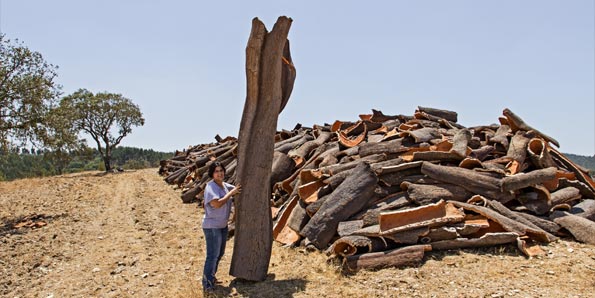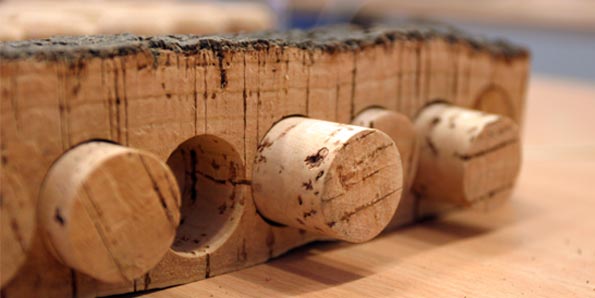bags
wallets
ACCESSORIES
tech
What is cork?
November 10, 2020 8 min read 0 Comments

What is cork?
Is cork the bark of a cork oak?
What is cork made of?
Cork is “simply” the bark of the cork oak tree however there is nothing simple about it. It’s much more than just a stunning on the outside raw material. Until today, no synthetic product was invented that can quite duplicate cork´s natural honeycomb-like cellular structure.
The perfect balance between several chemical components, where suberin takes the main position, turns cork into a natural wonder: light but still robust, impermeable to liquids and gases, elastic and compressible, thermal and acoustic insulator, fire retardant… we will talk more about those characteristics underneath.
What are cork's main characteristics?
- Very light
The honeycomb-like cellular structure of cork, where each cell is filled with gaseous elements similar to air, make of cork an extraordinarily light material. Each cubic centimeter of cork contains more than 40 million cells and weights only 0,16g. Amazing, right?

Is it Superwoman? Unfortunately, not! Cork is really, really light!
- Impermeable to liquids and gases
The suberin present in cork turns it impermeable to both liquids and gases. This amazing resistance to moisture allows it to age without deteriorating.
- Elastic and compressible
The cellular membranes, filled with a gas mixture similar to air, give cork the ability to be compressed to about half its thickness without losing any flexibility, in such a way that when decompressed cork recovers to its initial shape and volume. It can even face temperature and pressure variations without suffering variations. The only known solid that, when compressed on one side, does not increases in volume on the other.
- Thermal and acoustic insulator
The 40 million impermeable cells present in every single cubic centimeter of cork are isolated from each other by a substance that is resistant to moisture. This characteristic permits cork to be extremely good at absorbing decibels, vibration and heat.
- Fire retardant
A natural fire retardant, cork burns without a flame and during its slow combustion is doesn't emit toxic gases.
- Highly abrasion resistant
Cork’s high friction coefficient, derived from its honeycomb structure, gives it a resistance to abrasion much higher than that of other hard surfaces.
- Hypoallergenic
Cork doesn’t absorb dust therefore avoiding the appearance of mites and contributing, hence, to protection against allergies and is suitable for those who suffer from asthma. It is inalterable constitutionally and so its efficiency is guaranteed.
- Natural touch
A naturally uneven surface, combined with the softness and flexibility to the touch are one of corks biggest perks. Cork fabric has a very soft touch it’s even silkier than leather.
What is the chemical formula of cork?
What is the chemistry behind cork?
Cork amazing characteristics can only be fully explained with chemistry. So, if you really want to know more, here you have it:
The chemical formula of cork from Quercus suber L. is C123H182O56N.
The average chemical composition of cork is: 45% suberin; 27% lignin, 12% polysaccharides, 6% ceroids, 6% tannins.
Cork, a vegetable tissue which botanical designation is phellem, is a continuous, thick protective layer of suberised dead cells produced from phellogen tissue that grows around the tree stem without discontinuity. The phellogen has the ability to generate cells (meristematic capacity). Even after cellular division the phellogenic tissue continues to thicken and the tree perimeter enlarges, permitting the periodical exploitation of the trees. In the winter the tissue growth stops to only restart in the beginning of the spring. It’s during the spring/summer months that the phellogenium period happens. The winter standstill is clearly visible in the dark zones, marking off the cork produced each year. There are two very different types of cork: the first cork generated, produced by the original phellogen of the tree, named virgin cork, and the subsequent layery, formed by regenerated phellogens, designated reproduction cork. The virgin cork is hard-rough and crumbly due to its irregular structure, thickness and density. For these reasons virgin cork is not good to produce cork stoppers but can be used in cork boards, insulation, etc. The first reproduction cork, harvested about 9 years after the virgin, is still not good for cork stoppers even though it is significantly more regular than the virgin. “Amadia” is the name given to the best quality reproduction cork. While all types of cork can be used for agglomerates, only second reproduction and forward harvests have enough quality for cork stoppers.
How cork is produced?
So... we already know that the cork grows naturally on the cork oak tree and that is harvested by skilled men. But how does that raw material becomes a high quality cork stopper? There are very strict rules that regulate this process created by the European Cork Federation in order to guarantee the best final product possible.
- Stabilization period
The first step after the planks are extracted from the tree is to stack them in piles, either in the forest or in yards at a factory. They remain there exposed to the sun, wind and rain for at least six months.
These piles must be built according to the very specific regulations of the ICCSMP - International Code of Cork Stopper Manufacturing Practices, in order to allow the cork to stabilize. To prevent their contact with the soil, the piles must be stacked on inert materials. During these 6 months the raw material matures and the cork stabilizes.
- Boiling
One of the most important stages of the pre-processing industry is the boiling and should only start after the Stabilization period. The ICCSMP also prescribed strict rules for this stage and an increasing investment on quality certifications has been placed.
With the aim of cleaning, extracting the water soluble substances, increase their thickness, decrease their density and improve their smoothness and elasticity, the cork planks are immersed in clean boiling water for at least one hour. Controlled boiling processed in a closed environment, steam under pressure and processes to trap volatile substances are just some of the complementary procedures to optimize the boiling stage that some companies have introduced.
- Selection
After the boiling, the cork undergoes a new period of stabilization. The planks selection takes place after a period of up to 3 weeks, that serves to flatten the planks and to allow their size to stabilize. Only in this way will cork attain the consistency required for it to be transformed into cork stoppers.
- Slicing
After the selection, the planks are cut into strips just a bit wider than the length of the cork stoppers to be manufactured.
- Punching
This phase is where, manual or semi-automatically, the strips of cork are perforated with a drill. A cylindrical stopper is thus obtained with the desired size.

Strip of cork punched
- Granulating
Being a highly recyclable, natural, renewable and biodegradable material, the cork byproducts left from the punching stage are used for cork granulate.
So, the cork that is not directly used for natural cork stoppers will be granulated to make technical stoppers or other cork agglomerate products that are used for such varied functions as insulation, coverings, flooring, etc.
- Rectification
In order to obtain previously specified sizes and to regularize the surface of the cork stopper they undergo a rectification
- Selection
Finally it is time to separate stoppers into different grades, which can be determined by automatic scanning of their surface or by visual inspection. Besides the definition of grades, during this stage, defective stoppers are also eliminated.
- Washing
At this point, after rectification and selection, hydrogen peroxide or paracetic acid are used to wash the stoppers, which cleans and disinfects them. Microwaves or ozone are examples of other used methods. After the disinfection, result of the washing, the moisture level is stabilized, thus maximizing stopper performance as a seal and simultaneously ensuring good microbial stability.
- Colmation
Occasionally cork stoppers may be colmated, whose process seals the surface pores (lenticels) with a mixture of glue and cork powder result of natural cork stoppers rectification. Colmation improves the presentation of stoppers with many lenticels and helps to obtain a better seal.
- Printing or branding
According to the customer's specifications, the cork stoppers can now be ink printed (with food quality ink) or fire branded.
As a final finishing, the corks are given a silicon and/or paraffin treatment at the surface to make them easier to insert into the bottle and to be subsequently extracted by the final consumer.
- Packaging
The stoppers are packed in plastic bags with a specific amount of SO2 (sulphur dioxide), a gas that inhibits microbial growth, and are, then, ready to be delivered to wine or spirits bottlers.
What are the uses of cork?
The main sector for which cork products are destined is still the wine industry, which absorbs 70% of all production, followed by the building industry with more than 20%.
However, the increase in technological developments brought cork to a new level. The use of cork and its derivatives has grown almost exponentially, outside the stopper industry. It became important in the building industry due to its amazing thermal, acoustic and impermeable characteristics. But there are also an infinite number of other applications such as cork fabric goods, clothing, sports material, furniture, footwear, automotive and even the space industry.
These derivatives are obtained from byproducts generated in the production of corks, or from grinding virgin cork or from debris and waste of other processing operations.
- Expanded pure agglomerated cork
Essentially the result of grinding virgin cork heated to high temperatures. It's used, above all, as thermal, acoustic and vibration insulation and, due to its color, for decorative purposes.
- White agglomerate
Made from ground cork cuttings. This agglomerate can be used in countless everyday objects such as corkboards, footwear, trays, protective helmets, buoys, life jackets and floats, fishing rod handles, handbags or carpets. In sports it is used in various types of balls, in rackets, golf clubs or in dart boards. In industry it can be used for mechanical joints or anti-vibration material in a range of machinery.
- Rubbercork
Grains of cork combined with rubber. The rubbercork is manufactured using a quite different production technology with different areas of application. The combination of several cork characteristics such as elasticity with the strength of rubber is transformed into an essential material for electrical and automotive industries, in gaskets for engines, machinery and transformers and for heavy traffic flooring.
Why is Portuguese cork different from the others?
Actually, it isn't. Portuguese cork is known internationally because Portugal has the right climate and characteristics to grow cork oak trees and, together with Spain, owns more than half of the worlds cork forest. Also because cork is so intertwined with Portuguese history that it is already a part of our DNA. The art of harvesting cork is like a family heirloom and harvesters are really proud of their work. Naturally, we developed the industry around cork, made research and improvements and that is why we are, undeniably, the world leader in production, exporting and cork importing terms.
The numbers are self explanatory: Yearly the Portuguese export about 900 million euros in cork products and are responsible for around 60% of the world cork trade. If we talk about the trade in processed products the number ascents to around 80%. (Source: APCOR)
The installed capacity to process cork exceeds the its amount in Portugal, leading to a need of import. for this reason, Portugal is also the largest international importer of this raw material, which it processes and subsequently exports as final consumer products. (Source: APCOR)














